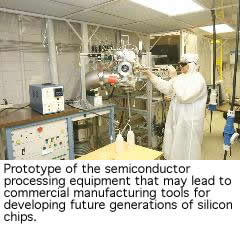Home > Press > Cooler, faster, cheaper: Clemson researchers advance process to manufacture silicon chips
 |
Abstract:
The next generation of laptops, desk computers, cell phones and other semiconductor devices may get faster and more cost-effective with research from Clemson University.
Cooler, faster, cheaper: Clemson researchers advance process to manufacture silicon chips
CLEMSON, SC | Posted on December 3rd, 2007 "We've developed a new process and equipment that will lead to a significant reduction in heat generated by silicon chips or microprocessors while speeding up the rate at which information is sent," says Rajendra Singh, D. Houser Banks Professor and director for the Center for Silicon Nanoelectronics at Clemson University.
The heart of many high-tech devices is the microprocessor that performs the logic functions. These devices produce heat depending on the speed at which the microprocessor operates. Higher speed microprocessors generate more heat than lower speed ones. Presently, dual-core or quad-core microprocessors are packaged as a single product in laptops so that heat is reduced without compromising overall speed of the computing system. The problem, according to Singh, is that writing software for these multicore processors, along with making them profitable, remains a challenge.
"Our new process and equipment improve the performance of the materials produced, resulting in less power lost through leakage. Based on our work, microprocessors can operate faster and cooler. In the future it will be possible to use a smaller number of microprocessors in a single chip since we've increased the speed of the individual microprocessors. At the same time, we've reduced power loss six-fold to a level never seen before. Heat loss and, therefore, lost power has been a major obstacle in the past," said Singh.
Participants in the research included Aarthi Venkateshan, Kelvin F. Poole, James Harriss, Herman Senter, Robert Teague of Clemson and J. Narayan of North Carolina State University at Raleigh. Results were published in Electronics Letters, Oct. 11, 2007, Volume: 43, Issue: 21,
pages: 1130-1131. The work reported here is covered by a broad-base patent of Singh and Poole issued to Clemson University in 2003.
The researchers say the patented technique has the potential to improve the performance and lower the cost of next-generation computer chips and a number of semiconductor devices, which include green energy conversion devices such as solar cells.
"The potential of this new process and equipment is the low cost of manufacturing, along with better performance, reliability and yield," Singh said. "The semiconductor industry is currently debating whether to change from smaller (300 mm wafer) manufacturing tools to larger ones that provide more chips (450 mm). Cost is the barrier to change right now. This invention potentially will enable a reduction of many processing steps and will result in a reduction in overall costs."
South Carolina has a growing semiconductor related industry, and the developers of this new process and equipment say it provides the potential for creating new jobs in the allied semiconductor equipment manufacturing industry.
####
About Clemson University
Today, Clemson is redefining the term “top-tier research university” by combining the best of two models: the scientific and technological horsepower of a major research university and the highly engaged academic and social environment of a small college. With a distinctive governance system that fosters stability in leadership, unique college structures that create an unmatched climate for collaboration, and a driven, competitive spirit that encourages faculty, staff and students to embrace bold, sometimes audacious, goals, Clemson has set its sights on being one of the nation’s top-20 public universities by 2011.
That vision — first outlined by President James F. Barker ’70 and officially adopted by the Board of Trustees in 2001 — has united members of the Clemson Family who understand what it takes to be a top research university and what Clemson’s success will mean for students, for South Carolina and for society.
For more information, please click here
Contacts:
Rajendra Singh
(864) 710-1311
WRITER: Susan Polowczuk
(864) 656-2063
Copyright © Clemson University
If you have a comment, please Contact us.Issuers of news releases, not 7th Wave, Inc. or Nanotechnology Now, are solely responsible for the accuracy of the content.
| Related News Press |
Chip Technology
![]() Lab to industry: InSe wafer-scale breakthrough for future electronics August 8th, 2025
Lab to industry: InSe wafer-scale breakthrough for future electronics August 8th, 2025
![]() A 1960s idea inspires NBI researchers to study hitherto inaccessible quantum states June 6th, 2025
A 1960s idea inspires NBI researchers to study hitherto inaccessible quantum states June 6th, 2025
![]() Programmable electron-induced color router array May 14th, 2025
Programmable electron-induced color router array May 14th, 2025
Discoveries
![]() Researchers develop molecular qubits that communicate at telecom frequencies October 3rd, 2025
Researchers develop molecular qubits that communicate at telecom frequencies October 3rd, 2025
![]() Next-generation quantum communication October 3rd, 2025
Next-generation quantum communication October 3rd, 2025
![]() "Nanoreactor" cage uses visible light for catalytic and ultra-selective cross-cycloadditions October 3rd, 2025
"Nanoreactor" cage uses visible light for catalytic and ultra-selective cross-cycloadditions October 3rd, 2025
Announcements
![]() Rice membrane extracts lithium from brines with greater speed, less waste October 3rd, 2025
Rice membrane extracts lithium from brines with greater speed, less waste October 3rd, 2025
![]() Researchers develop molecular qubits that communicate at telecom frequencies October 3rd, 2025
Researchers develop molecular qubits that communicate at telecom frequencies October 3rd, 2025
![]() Next-generation quantum communication October 3rd, 2025
Next-generation quantum communication October 3rd, 2025
![]() "Nanoreactor" cage uses visible light for catalytic and ultra-selective cross-cycloadditions October 3rd, 2025
"Nanoreactor" cage uses visible light for catalytic and ultra-selective cross-cycloadditions October 3rd, 2025
|
|
||
|
|
||
| The latest news from around the world, FREE | ||
|
|
||
|
|
||
| Premium Products | ||
|
|
||
|
Only the news you want to read!
Learn More |
||
|
|
||
|
Full-service, expert consulting
Learn More |
||
|
|
||








